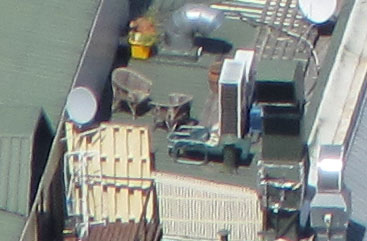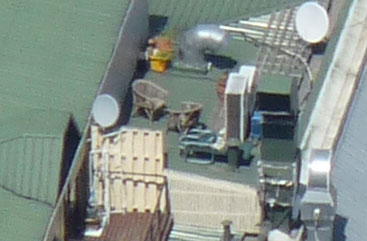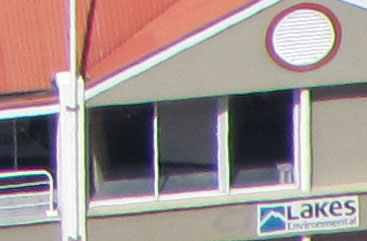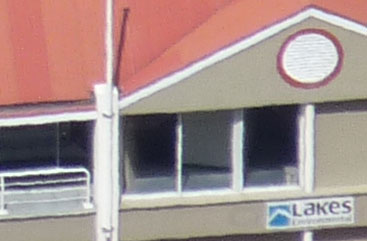Canon PowerShot SX10 IS
-
-
Written by Gordon Laing
Canon PowerShot SX10 IS vs Panasonic FZ28 vs EOS 450D / XSi
Canon PowerShot SX10 IS vs Panasonic Lumix FZ28
outdoor scene telephoto
First things first: the composition above was taken from the same location as our first shot at the top of the page, albeit with the cameras tilted down a little. So take another look at our first shot and start at the bottom of the image in the middle and work your way up until you reach the corner of the inlet – that’s what you’re looking at here in close-up. In short, both cameras boast enormous optical zoom ranges taking you from decent wide angle to super-telephoto capabilities. The question though is whether the quality is compromised as a result. Below we’ve compared crops taken from each camera zoomed-into their maximum focal lengths of 560mm for the Canon and 468mm for the Panasonic. With the longer focal length, the SX10 IS crops show a smaller area. We chose not to match the field of view here, instead wanting to see how each compared when fully zoomed-in. Analysis of the crops below essentially results in a repeat of those above: the PowerShot SX10 IS exhibits greater coloured fringing around high contrast areas in the corners, but enjoys crisper, cleaner details. So once again, despite impressively low fringing, the FZ28’s crops are softer and marred by a fine texture of noise which becomes more obvious if you increase the sharpening. Interestingly this was also present on its predecessor, but it still out-performed rival super-zooms at the time. Now Canon has taken the bull by the horns and raised the game with the SX10 IS. But to be fair both cameras are still delivering very respectable results here given their extreme zoom ranges. Given the often disappointing quality of earlier super-zooms, it’s impressive just how good they’ve now become. It’s just a shame the SX10 IS doesn’t offer in-camera reduction of fringing or a RAW option for easier removal later. And in the absence of RAW results, it’s now time for some controlled studio tests on our Canon PowerShot SX10 IS Studio Resolution page.
|
Canon PowerShot SX10 IS results continued…
 |
outdoor scene
 |
To compare real-life performance we shot the same scene with the Canon PowerShot SX10 IS, Panasonic Lumix FZ28 and Canon EOS 450D / XSi within a few moments of each other using their best quality JPEG and lowest ISO settings. The lenses on each camera were adjusted to deliver the same vertical field of view. The image left was taken with the Canon PowerShot SX10 IS at 7mm f4 and with a sensitivity of 80 ISO; the original Super-fine JPEG measured 5.02MB. The crops are taken from the upper left, center, lower right and lower left portions of the originals and presented here at 100%. |
Note the Canon 450D / XSi captures wider 3:2 aspect ratio images, so by matching the vertical field of view, we’re effectively treating the DSLR here as a 10.8 Megapixel camera, delivering 4:3 shaped images.
Starting with the top row of crops, taken from the mountain ridge in the upper left corner of the image, it’s clear both Canon models are suffering from greater coloured fringing than the Panasonic. Indeed like the Lumix FZ18 before it, the new FZ28 impressively manages to avoid fringing even in high contrast areas towards the corners. This may be down to better corrected optics in this regard, lower sensor blooming, digital correction or any combination of the three, but either way, the FZ28’s in-camera JPEGs, like its predecessor, are essentially bereft of the issue.
Looking at the rest of the crops though, the PowerShot SX10 IS has the advantage over the Panasonic. One glance shows them to be cleaner and better defined – indeed the FZ28 crops viewed at 100% look almost as if a veil were in front of them. This isn’t an isolated case or a technical error. We repeated the test on different days and also compared other examples at different apertures, but in each case the FZ28’s images were softer than the Canon’s. The same effect can also be seen on other Panasonic models including the LX3 and FZ18 – their in-camera JPEGs are just lacking the bite of some rivals.
Now much of this is down to image processing, with the Canon SX10 IS applying greater sharpening and contrast for a punchier result. By doing the same to the FZ28’s images, you can begin to match the output seen below, but this will in turn reveal greater background noise textures than its rival. Perhaps Panasonic keeps the sharpening relatively low to avoid this problem.
So despite suffering from more fringing in high contrast areas, the SX10 IS gives a good result here at its lowest sensitivity. It also performs well against the 450D / XSi when equipped with its kit lens. Like most DSLRs, the 450D / XSi’s default output is softer than a consumer model like the SX10 IS and can certainly be sharpened-up if preferred, but no processing can improve the softness seen in the lower right corner of images taken with our EF-S 18-55mm IS sample (as seen in the third row of crops).
Of course this test was with both super-zooms set to close to their widest focal lengths. Scroll to the bottom of this page to see a second set of examples taken with both cameras fully zoomed-into their maximum focal lengths to see how they compare at their extremes. Alternatively if you want to skip straight to detail results taken in a more controlled environment, head on to our Canon PowerShot SX10 IS Studio Resolution page.
Canon PowerShot SX10 IS |
Panasonic Lumix DMC FZ28 |
Canon EOS 450D / Rebel XSi | ||
 |
 |
 | ||
f4, 80 ISO |
f5.6, 100 ISO |
f8, 100 ISO | ||
 |
 |
 | ||
f4, 80 ISO |
f5.6, 100 ISO |
f8, 100 ISO | ||
 |
 |
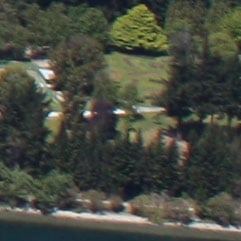 | ||
f4, 80 ISO |
f5.6, 100 ISO |
f8, 100 ISO | ||
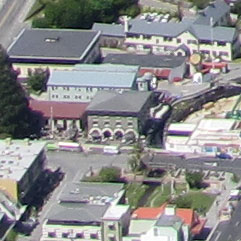 |
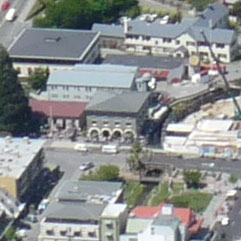 |
 | ||
f4, 80 ISO |
f5.6, 100 ISO |
f8, 100 ISO |






